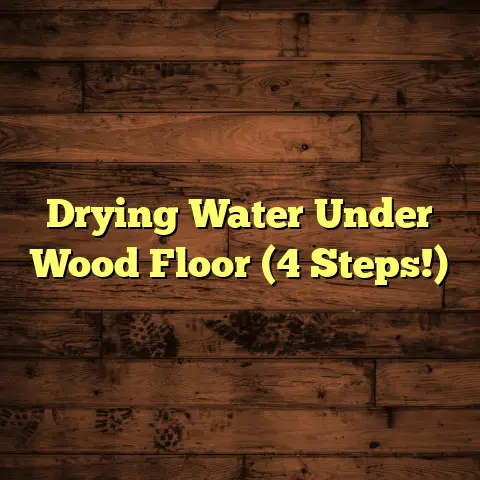Level Floors In Old House? (4 Steps To Flat!)
Would you rather navigate the creaks and slopes of an old, uneven floor or enjoy the stability and aesthetic of a perfectly level surface beneath your feet?
If you’ve chosen the latter, you’re not alone!
Many homeowners of vintage houses face the
challenge of addressing uneven floors, which
can not only detract from the beauty of a space
but also affect its functionality.
As a flooring contractor with over 20 years
under my belt, I’ve seen it all.
From century-old
farmhouses to charming Victorian homes, I’ve
wrestled with my fair share of sloping floors.
And let me tell you, there’s nothing quite like the feeling of transforming a wonky, unstable surface into a solid, level foundation.
In this article, I’m going to share my tried-and-true methods for leveling floors in old houses.
I’ll walk you through the process step-by-step, from understanding the causes of unevenness to choosing the right leveling method and executing the job like a pro.
So, grab your measuring tape and let’s get started!
1. Understanding the Causes of Uneven Floors
Old houses have character, no doubt.
But with
that character often comes the less-desirable
trait of uneven floors.
Why is this such a
common issue?
Well, there are several culprits, and understanding them is the first step in tackling the problem.
Settling Foundations: This is probably the biggest offender.
Over time, the ground beneath a house shifts and settles, and this can cause the foundation to move unevenly.Think of it like this: imagine building a sandcastle on the beach.
At first, it’s solid, but as the tide comes in, parts of the base start to erode, causing the whole structure to tilt.
The same thing can happen to a house over decades.According to the American Society of Civil Engineers, foundation settlement is a common issue, affecting approximately 25% of homes in the United States during their lifespan.
Moisture Issues: Water is a powerful force, and it can wreak havoc on a home’s structure.
Excessive moisture can lead to wood rot, which weakens the floor joists and subfloor, causing them to sag or warp.I’ve seen cases where a leaky pipe under a kitchen sink has caused significant floor damage over just a few years.
The key here is to identify and address any sources of moisture, such as leaky roofs, poor drainage, or plumbing problems, before attempting to level the floors.
The Environmental Protection Agency (EPA) estimates that 10-15% of homes in the US have moisture problems that contribute to structural damage.
Natural Wear and Tear: Let’s face it: old houses have been through a lot.
Years of foot traffic, heavy furniture, and general use can take their toll on the floors.Think about it: that beautiful hardwood floor has probably seen generations of families, countless parties, and maybe even a few dance-offs.
Over time, the wood can compress, warp, or simply wear down, creating uneven surfaces.
Historical Construction Methods and Materials: Older homes were often built using different techniques and materials than modern houses.
For example, instead of engineered lumber, they might have used full-dimension lumber, which is more prone to warping and twisting as it dries.
Also, the original subfloors might have been made of wide planks that are now shifting and separating.
I remember working on a house built in the 1880s where the floor joists were actually tree trunks that had been roughly hewn into shape!
While charming, they were far from perfectly straight and level.How Different Flooring Materials React: The type of flooring material also plays a role in how it reacts to unevenness.
-
Wood: Hardwood floors are generally pretty resilient, but they can warp or cup if exposed to moisture.
They can also become uneven if the subfloor underneath them is not level. -
Tile: Tile is rigid, so it’s very unforgiving of uneven surfaces.
If the subfloor isn’t perfectly flat, the tiles can crack or become loose. -
Laminate: Laminate flooring is relatively thin and flexible, so it can conform to minor imperfections in the subfloor.
However, if the unevenness is too severe, the laminate can buckle or separate at the seams. -
Vinyl: Similar to laminate, vinyl can handle some unevenness, but it’s not a miracle worker.
Large dips or bumps will show through the vinyl and can even cause it to tear over time.
-
Understanding these causes is crucial for
determining the best approach to leveling your
floors.
Now, let’s move on to assessing the
problem.
2. Assessing the Problem
Alright, so you suspect your floors are uneven.
But how do you know for sure?
And how do you
determine the severity of the problem?
That’s
where assessment comes in.
Here’s my step-by-step guide to evaluating your floors for levelness:
Gather Your Tools: You’ll need a few basic tools to get started:
-
Level: A standard spirit level (2-4 feet long) is essential for checking levelness over short distances.
-
Laser Level: A laser level is a game-changer for larger areas.
It projects a perfectly level line across the room, allowing you to easily identify high and low spots. -
Measuring Tape: You’ll need a measuring tape to measure the height differences between various points on the floor.
-
Straightedge: A long, straight piece of wood or metal (6-8 feet) can be used to detect dips and humps in the floor.
-
Notebook and Pen: Keep a notebook and pen handy to record your measurements and observations.
-
Visual Inspection: Start by simply walking around the room and visually inspecting the floors.
Look for:-
Obvious Slopes or Dips: Can you see any areas where the floor is noticeably sloping or dipping?
-
Gaps Under Baseboards: Gaps between the baseboards and the floor can indicate that the floor has settled unevenly.
-
Cracks in Tile or Grout: Cracks in tile or grout lines are a sign that the subfloor is shifting.
-
Buckling or Warping: Look for areas where the flooring material is buckling or warping.
-
Using a Level: Place the level on the floor in various locations, both along the walls and in the center of the room.
Check the bubble to see if the floor is level.If the bubble is not centered, measure the distance between the level and the floor at the high point.
This will give you an indication of how much the floor is out of level.Using a Laser Level: Set up the laser level in the center of the room and turn it on.
The laser will project a level line around the room.Use a measuring tape to measure the distance between the laser line and the floor at various points.
This will give you a precise measurement of the height differences across the room.Using a Straightedge: Place the straightedge on the floor and look for gaps underneath it.
The size of the gaps will indicate the depth of any dips or humps in the floor.Create a Floor Map: Draw a simple sketch of the room and mark the locations of any uneven areas.
Note the height differences you measured with the level, laser level, or straightedge.This floor map will be invaluable when you start planning your leveling strategy.
DIY or Pro? After assessing the problem, you’ll need to decide whether it’s a DIY project or if you should call in a professional.
Here’s a general guideline:-
Minor Unevenness (Less than 1/4 inch over 6 feet): You can probably handle this yourself using self-leveling compound or shimming.
-
Moderate Unevenness (1/4 inch to 1 inch over 6 feet): This might be a DIY project if you’re comfortable with more advanced techniques, such as installing a new subfloor.
-
Severe Unevenness (More than 1 inch over 6 feet): This is definitely a job for a professional.
It likely indicates a serious structural problem that needs to be addressed.
-
Checklist for Identifying Severity:
Remember, safety is always the top priority.
If you’re not comfortable with any aspect of
the project, don’t hesitate to call in a professional.
With a thorough assessment under your belt,
you’re now ready to start planning your leveling
strategy.
Let’s move on to the next step: choosing
the right leveling method.
3. Step-by-Step Solutions
Okay, you’ve assessed your floors and you’re
ready to take action.
Now comes the fun part:
actually leveling the floors!
This is where the rubber meets the road, so pay close attention.
Step 1: Prepare the Area
Before you start slinging self-leveling compound
or hammering in shims, you need to properly
prepare the area.
This will ensure a smooth,
efficient, and safe leveling process.
Clear the Space: Remove all furniture, rugs, and other obstructions from the room.
This will give you plenty of space to work and prevent accidental damage to your belongings.I recommend moving everything to another room or, if that’s not possible, covering the furniture with plastic sheeting to protect it from dust and debris.
Protect Other Areas of the Home: Leveling floors can be a messy job, so it’s important to protect other areas of your home from dust and debris.
Cover doorways with plastic sheeting and seal the edges with painter’s tape.
You might also want to lay down drop cloths or plastic sheeting on the floors in adjacent rooms.-
Remove Existing Flooring (If Necessary): Depending on the leveling method you choose, you may need to remove the existing flooring.
For example, if you’re using self-leveling compound, you’ll typically need to remove any carpet, tile, or laminate flooring.
If you’re installing a new subfloor, you’ll need to remove the existing subfloor as well.
Be sure to wear appropriate safety gear, such as gloves and a dust mask, when removing old flooring.
Inspect and Repair Underlying Issues: Before you start leveling, take the time to inspect the subfloor and floor joists for any signs of damage, such as rot, mold, or insect infestation.
Repair any damaged areas before proceeding with the leveling process.
This might involve replacing rotted floor joists or patching holes in the subfloor.Also, check for any plumbing or electrical issues that might affect the flooring work.
Address any leaks or wiring problems before you start leveling.Clean the Subfloor: Once you’ve removed the old flooring and repaired any underlying issues, thoroughly clean the subfloor.
Sweep or vacuum up any dust, debris, or loose particles.
You might also want to scrub the subfloor with a mild detergent to remove any grease or grime.A clean subfloor will ensure that the leveling material adheres properly.
Step 2: Choose the Right Leveling Method
Now that you’ve prepped the area, it’s time to
choose the right leveling method.
There are
several options available, each with its own
pros and cons.
Self-Leveling Compound: Self-leveling compound is a cement-based mixture that you pour onto the subfloor.
It then flows and spreads out, automatically leveling the surface.-
Pros: Relatively easy to use, self-levels, good for minor to moderate unevenness.
-
Cons: Can be expensive, requires careful preparation, not suitable for large height differences.
-
Cost: \$30-\$50 per bag (covers approximately 50 square feet at 1/8 inch thickness).
-
Skill Level: Beginner to Intermediate.
-
-
Shimming: Shimming involves inserting thin pieces of wood or plastic (shims) between the floor joists and the subfloor to raise the low spots.
-
Pros: Inexpensive, good for localized unevenness, allows for precise adjustments.
-
Cons: Time-consuming, requires access to the floor joists, not suitable for large areas.
-
Cost: \$10-\$20 per bag of shims.
-
Skill Level: Intermediate to Advanced.
-
-
Installing a New Subfloor: This involves removing the existing subfloor and installing a new one that is perfectly level.
-
Pros: Provides a completely level surface, good for large areas, can address structural issues.
-
Cons: Most expensive option, requires significant demolition and construction work, not always necessary.
-
Cost: \$2-\$5 per square foot (for materials only).
-
Skill Level: Advanced.
-
-
Grinding High Spots: This method involves using a concrete grinder to remove high spots in the concrete slab.
-
Pros: Effective for concrete floors, relatively quick, can be used in conjunction with other methods.
-
Cons: Requires specialized equipment, can be dusty, not suitable for wood floors.
-
Cost: Rental of concrete grinder: \$50-\$100 per day.
-
Skill Level: Intermediate.
-
Table: Leveling Method Comparison
Step 3: Execute the Leveling Process
Alright, you’ve chosen your leveling method.
Now it’s time to get to work!
I will walk you
through the basic steps for each method.
Self-Leveling Compound:
-
Prime the Subfloor: Apply a primer to the subfloor to improve adhesion and prevent bubbles from forming in the compound.
Mix the Compound: Follow the manufacturer’s instructions to mix the self-leveling compound.
Use a mixing drill and a large bucket to ensure a smooth, consistent mixture.Pour the Compound: Pour the compound onto the subfloor, starting in the lowest area.
Use a gauge rake to spread the compound evenly and ensure that it reaches all corners and edges.Allow to Dry: Let the compound dry completely according to the manufacturer’s instructions.
This may take several hours or even days, depending on the thickness of the compound and the ambient temperature.
Shimming:
-
Locate Low Spots: Use a level or straightedge to identify the low spots in the floor.
-
Access Floor Joists: You may need to cut access holes in the subfloor to reach the floor joists.
-
Insert Shims: Insert shims between the floor joists and the subfloor, raising the low spots until they are level with the surrounding area.
-
Secure Shims: Secure the shims in place with construction adhesive or screws.
-
Patch Access Holes: Patch the access holes in the subfloor with plywood or other suitable material.
Installing a New Subfloor:
-
Remove Existing Subfloor: Carefully remove the existing subfloor, being careful not to damage the floor joists.
Inspect Floor Joists: Inspect the floor joists for any signs of damage or unevenness.
Repair or replace any damaged joists.Install New Subfloor: Install the new subfloor, using screws or nails to secure it to the floor joists.
Make sure the subfloor is perfectly level before proceeding.
Grinding High Spots:
-
Prepare the Area: Clear the area and protect surrounding surfaces from dust.
-
Rent a Concrete Grinder: Rent a concrete grinder with a diamond grinding wheel.
-
Grind High Spots: Carefully grind down the high spots in the concrete slab, using the grinder in a sweeping motion.
-
Clean Up: Vacuum up the dust and debris after grinding.
Step 4: Finishing Touches
You’ve leveled your floors!
Now it’s time for
the finishing touches.
This will ensure that
your newly leveled floors look great and last
for years to come.
-
Install New Flooring or Repair Existing Materials: Once the leveling process is complete, you can install new flooring or repair the existing materials.
If you’re installing new flooring, be sure to follow the manufacturer’s instructions carefully.
If you’re repairing existing materials, such as hardwood floors, you may need to sand, stain, and refinish the surface to match the surrounding areas.
-
Aesthetic Considerations: When choosing new flooring or repairing existing materials, consider the aesthetic of the room.
Choose colors and textures that complement the existing décor and create a cohesive look.
Pay attention to details such as the direction of the flooring planks or the pattern of the tile.
-
Maintain the Newly Leveled Surface: To keep your newly leveled floors looking their best, follow these maintenance tips:
-
Clean Regularly: Sweep or vacuum the floors regularly to remove dust and debris.
-
Use Appropriate Cleaners: Use cleaners that are specifically designed for your flooring material.
-
Protect from Moisture: Avoid excessive moisture, which can damage the flooring and cause it to warp or buckle.
-
Use Furniture Pads: Place furniture pads under the legs of heavy furniture to prevent scratches and dents.
-
4. Conclusion
Maintaining level floors in an old house is
crucial for safety, comfort, and aesthetics.
Uneven floors can pose tripping hazards, make
furniture unstable, and detract from the overall
appearance of your home.
While the process of leveling floors may seem daunting, the rewards of a flat, stable surface are well worth the effort.
Not only will you improve the safety and functionality of your home, but you’ll also enhance its value and curb appeal.
Remember, you don’t have to tackle this project
alone.
If you’re not comfortable with any aspect
of the process, don’t hesitate to call in a
professional.
As a flooring contractor, I’ve seen firsthand
the transformative power of level floors.
It’s
amazing how much of a difference it can make
in the overall look and feel of a home.
So, take action today and start enjoying the
comfort and stability of level floors in your
old house!
The satisfaction of home improvement
and the potential to enhance the overall value
of your property are well within your reach.





